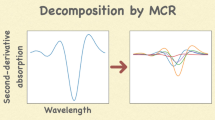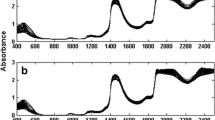Abstract
Variables selection is often necessary to remove redundant data and to reduce the negative influence of spectral overlapping. In the current work, two interval variable selection methods were applied to quantify five coloring agents (Tartrazine TAR, Sunset Yellow SY, Allura Red AR, Brilliant Blue BBL, and Brilliant Black BBK) which exhibited intense spectral overlapping in powdered soft drinks. Interval partial least squares iPLS and net analyte signal NAS methodology were used to pick up the most informative variables for dyes quantification in powdered soft drinks. Based on NAS calculations, the optimum sensitivity and selectivity for dyes measurement were found to be (1.23–5.56) and (0.30–0.72), respectively and at pH 3.0. Moreover, the minimum spectral overlapping (28–70%) among dyes was observed at pH 3.0 while the maximum overlapping (38–74%) was at pH 10.0. Interval partial least squares iPLS was more capable to handle the overlapping between SY and AR dyes. On the other hand, net analyte signal method was effective to capturing the informative regions for dyes of lower spectral overlapping, TAR, BBL, and BBK. In the case of AR, the best prediction (REP% 2.4) was achieved at 350–530 nm using iPLS. However, the best prediction of BBL (REP% 3.4%) was achieved at 655–680 nm (i.e., 6 variables) using NAS/PLS regression. The ability NAS/PLS regression, which uses fewer number of variables, was attributed to NAS mechanism which extracts the net signal of the analyte, thus; preventing overlapping with the rest of compounds signals and this will elegantly leads to fewer number of variables. The superiority of iPLS to calibrate intensely overlapping dyes is attributed to its inherent mechanism of selecting the spectral data that include all possible variables leading to better prediction. At the optimum calibration conditions, the dyes were detected in powdered soft drinks with adequate accuracy (%recoveries 97.3–107.5) and precision (RSD 3.1–9.30). The maximum total concentration of dyes was reported in orange drink samples reaching to 567 mg/kg. The result highlights and emphasizes the highly required further monitoring of this type of food, considering the damages of such popular synthetic dyes to human health. Analysis of results by ANOVA indicated that the total content of dyes was statistically comparable in the samples while the total content of each single dye was statistically different in tested samples.






Similar content being viewed by others
References
A.C. Olivieri, Introduction to Multivariate Calibration A Practical Approach (Springer, Switzerland, 2018).
G.M. Escandar, N.M. Faber, H.C. Goicoechea, M. de la Peña, A. Olivieri, R. Poppi, Second and third-order multivariate calibration: data, algorithms and applications. Trends Anal. Chem. 26, 752–765 (2007)
G.M. Escandar, H.C. Goicoechea, M. de la Peña, A.C. Olivieri, Second- and higher-order data generation and calibration: a tutorial. Anal. Chim. Acta 806, 8–26 (2014)
A.C. Olivieri, Practical guidelines for reporting results in single- and multi-component analytical calibration: a tutorial. Anal. Chim. Acta 868, 10–22 (2015)
R.G. Brereton, Applied Chemometrics for Scientists (Wiley, New York, 2007).
S. Sxahin, E. Sarıburun, C. Demir, Net analyte signal-based simultaneous determination of dyes in environmental samples using moving window partial least squares regression with UV-vis spectroscopy. Anal. Methods 1, 208–214 (2009)
R.Z. Al Bakain, Y.S. Al-Degs, A.H. El-Sheikh, S. Arar, Spectrophotometric determination of melamine in liquid milk by multivariate second order calibration. Curr. Anal. Chem. 12, 74–84 (2016)
B. Hemmateenejad, R. Ghavami, R. Miri, M. Shamsipur, Net analyte signal-based simultaneous determination of antazoline and naphazoline using wavelength region selection by experimental design-neural networks. Talanta 68, 1222–1229 (2006)
B. Hemmateenejad, S. Yousefinejad, Multivariate standard addition method solved by net analyte signal calculation and rank annihilation factor analysis. Anal. Bioanal. Chem. 394, 1965–1975 (2009)
B. Salameh, Y.S. Al-Degs, K. Abu-Safieh, A.W. Al-Zghool, Novel application of multivariate standard addition method based on net analyte signal for quantification of artificial sweeteners in complex food matrices. J. Food Meas. 14, 78–87 (2020)
L. Xu, I. Schechter, A calibration method free of optimum factor number selection for automated multivariate analysis. Experimental and theoretical study. Anal. Chem. 69, 3722–3730 (1997)
H.C. Goicoechea, A.C. Olivieri, A comparison of orthogonal signal correction and net analyte preprocessing methods. Theoretical and experimental study. Intell. Lab. Syst. 56, 73–81 (2001)
A. Munz de la Pena, A.E. Mansilla, M.I.A.A. Valenzuela, H.C. Goicoechea, A.C. Olivieri, Comparative study of net analyte signal-based methods and partial least squares for the simultaneous determination of amoxycillin and clavulanic acid by stopped-flow kinetic analysis. Anal. Chim. Acta 463, 75–88 (2002)
J.H. Jiang, R.J. Berry, H.W. Siesler, Y. Ozaki, Wavelength interval selection in multicomponent spectral analysis by moving window partial least-squares regression with applications to mid-infrared and near-infrared spectroscopic data. Anal. Chem. 74, 3555–3565 (2002)
C.H. Spiegelman, M.J. McShane, M.J. Goetz, M. Motamedi, Q.L. Yue, G.L. Cote, Theoretical justification of wavelength selection in PLS calibration: development of a new algorithm. Anal. Chem. 70, 35–44 (1998)
B. Deng, Y. Yun, P. Ma, C. Lin, D. Ren, Y. Liang, A new method for wavelength interval selection that intelligently optimizes the locations, widths and combinations of the intervals. Analyst 140, 1876–2188 (2015)
S. Derksen, H. Keselman, Backward, forward and stepwise automated subset selection algorithms: frequency of obtaining authentic and noise variables. Br. J. Math. Stat. Psychol. 45, 265–282 (1992)
R. Leardi, A.L. González, Genetic algorithms applied to feature selection in PLS regression: how and when to use them. Chemom. Intell. Lab. Syst. 41, 195–207 (1998)
M. Shamsipur, V. Zare-Shahabadi, B. Hemmateenejad, M. Akhond, Ant colony optimisation: a powerful tool for wavelength selection. J. Chemom. 20, 146–157 (2006)
H.D. Li, Y.Z. Liang, Q.S. Xu, D.S. Cao, Key wavelengths screening using competitive adaptive reweighted sampling method for multivariate calibration. Anal. Chim. Acta 648, 77–84 (2009)
B.C. Deng, Y.H. Yun, Y.Z. Liang, L.Z. Yi, A novel variable selection approach that iteratively optimizes variable space using weighted binary matrix sampling. Analyst 139, 4836–4845 (2014)
L. Norgaard, A. Saudland, J. Wagner, J.P. Nielsen, L. Munck, S. Engelsen, Interval partial least-squares regression (iPLS): a comparative chemometric study with an example from near-infrared spectroscopy. Appl. Spectrosc. 54, 413–419 (2000)
W. Yang, W. Wang, R. Zhang, F. Zhang, Y. Xiong, T. Wu, W. Chen, Y. Du, A modified moving-window partial least-squares method by coupling with sampling error profile analysis for variable selection in near-infrared spectral analysis. Anal Sci 36, 303–309 (2020)
H. Goicoechea, A.C. Olivieri, Wavelength selection by net analyte signals calculated with multivariate factor-based hybrid linear analysis (HLA). A theoretical and experimental comparison with partial least-squares (PLS). Analyst 124, 725–731 (1999)
A.D. Gomes, M. Alcaraz, H.C. Goicoechea, M. Araújo, The Successive Projections Algorithm for interval selection in trilinear partial least-squares with residual bilinearization. Anal. Chim. Acta 811, 13–22 (2014)
L.P. Brás, M. Lopes, A.P. Ferreira, J.C. Menezes, A bootstrap-based strategy for spectral interval selection in PLS regression. J. Chemom. 22, 695–700 (2008)
J. Abdelghani, Y. Al-Degs, A. Issa, Rapid and reliable chromatograhic method to monitor coloring agents in highly consumed beverages. J. Food Proce. Preserv. 44, e14431 (2020)
R. Bhat, P. Mathur, Changing scenario of food colors in India. Curr. Sci. 74, 198–202 (1998)
J. Abdelghani, Y. Al-Degs, A. El-Sheikh, I. Fasfous, A. Al-Asafrah, Quick monitoring of coloring agents in highly consumed candies using multivariate calibration. Arab J. Chem. 13, 4228–4236 (2020)
S. Dixit, S. Purshottam, S. Khanna, M. Das, Usage pattern of synthetic colors in different states of India and exposure assessment through commodities preferentially consumed by children. Food Addit. Contamin. A 28, 966–1005 (2011)
S. Komissarchik, G. Nyanikova, Test systems and a method for express detection of synthetic food dyes in drinks. LWT Food Sci. Technol. 58, 315–320 (2014)
T. Gan, J. Sun, W. Meng, L. Song, Y. Zhang, Electrochemical sensor based on graphene and mesoporous TiO2 for the simultaneous determination of trace colourants in food. Food Chem. 141, 3731–3737 (2013)
F. de Andrade, M. Guedes, I. Vieira, F. Mendes, P. Rodrigues, C. Maia, M. Avila, L. Ribeiro, Determination of synthetic food dyes in commercial soft drinks by TLC and ion-pair HPLC. Food Chem. 157, 193–198 (2014)
A. Olivieri, H. Goicoechea, F. Iñón, MVC1: an integrated Matlab toolbox for first-order multivariate calibration. Chemom. Intell. Lab. Syst. 73, 189–197 (2004)
B. Hemmateenejad, A. Abbaspour, H. Maghami, R. Miri, M. Panjehshahin, Partial least squares-based multivariate spectral calibration method for simultaneous determination of beta-carboline derivatives in Peganum harmala seed extracts. Anal. Chim. Acta 575, 290–299 (2006)
CODEX STAN 192–1995. General Standard for Food Additives CODEX STAN 192–1995. World Health Organization, USA (2019)
Acknowledgements
We would like to thank the technical assistance (Bassem Nasrallah) for help with spectral analysis.
Funding
This research was funded by the Deanship of Graduate Studies, the Hashemite University, Zarqa, Jordan.
Author information
Authors and Affiliations
Contributions
YSAD, AHES: Conceptualization and Supervising. YSAD, AHES, AIS, AYAR: Methodology, Analysis, Validation. YSAD, AIS: Writing- Reviewing and Editing.
Corresponding author
Ethics declarations
Conflict of interest
The authors declare no conflict of interest.
Additional information
Publisher's Note
Springer Nature remains neutral with regard to jurisdictional claims in published maps and institutional affiliations.
Rights and permissions
About this article
Cite this article
Al-Degs, Y.S., El-Sheikh, A.H., Saleh, A.I. et al. Interval wavelength selection and simultaneous quantification of spectrally overlapping food colorants by multivariate calibration. Food Measure 15, 2562–2575 (2021). https://doi.org/10.1007/s11694-021-00848-3
Received:
Accepted:
Published:
Issue Date:
DOI: https://doi.org/10.1007/s11694-021-00848-3




